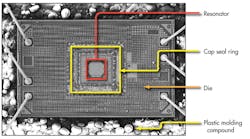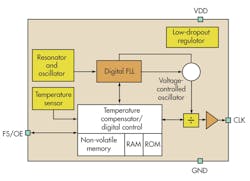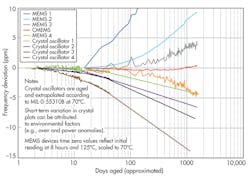Transform Traditional Frequency Control With CMOS+MEMS Integration
To alleviate the drawbacks of quartz oscillator technology, classic microelectromechanical systems (MEMS) materials are now being used to fabricate three-dimensional resonating structures. These MEMS-based resonators provide a viable alternative to quartz-based resonators with the advantage that they are fabricated and sealed in a vacuum using highly specialized semiconductor process technology.
MEMS-based oscillators are often constructed by wire-bonding the resonator die to the CMOS oscillator die (Fig. 1). These so-called two-die MEMS oscillators are typical of the first generation of MEMS oscillators on the market today.
They introduced a major improvement in the manufacture of oscillators by eliminating the complicated materials processing techniques required by quartz-based oscillators. They also replaced the ceramic package and metal lid with a more economical plastic package. Finally, the manufacturing yield of the resonator is improved because it is batch-fabricated on silicon wafers using precision semiconductor equipment.
Related Articles
- Look Inside Programmable MEMS Clock Chips
- Inside Silicon Labs' CMEMS Resonators
- Inside SiTimes' Reonators
Despite the enhancements that these first-generation MEMS devices bring to the oscillator manufacturing flow, there is further room for improvement to match the performance of quartz-based solutions while retaining the flexibility and scalability of CMOS-based manufacturing lines.
The two-die approach requires wire bonding between the resonator die and the oscillator die. These wire bonds add cost and complexity to the design and provide a path for noise coupling into the oscillator circuit. In addition, the inductance of the bond wires complicate circuit design in higher-performance applications that would benefit from using a higher-frequency resonator.
Also, temperature stability and short-term stability are below standard as the separation between the fast-drifting MEMS device and its compensation electronics do not allow the system to quickly respond to fast thermal transients. Supply chain headaches can arise as well because the materials required for the resonator die are fabricated in lower-volume, boutique semiconductor foundries.
Monolithic Die
Integrating MEMS and CMOS technologies in a single monolithic die can eliminate many of the disadvantages of conventional two-die MEMS oscillator solutions (Fig. 2). Silicon Labs’ CMEMS technology is the basis for a single-die oscillator solution, enabling the post-processing of MEMS structures on a CMOS wafer and benefitting from the scalability of high-volume wafer manufacturing. This CMOS+MEMS process allows the MEMS structure to be fabricated directly on top of a CMOS wafer.
Traditional MEMS processing using single-crystal silicon materials is incompatible with a monolithic CMOS implementation because the very high fabrication temperatures (>1000oC) required by these materials would destroy the underlying CMOS circuitry.
The new CMEMS process incorporates a MEMS material called poly-silicon germanium (poly-SiGe), which uses much lower fabrication temperatures that are compatible with building MEMS structures on top of a CMOS wafer but retain the excellent mechanical properties of crystalline materials.
A key area for improvement in traditional two-die MEMS solutions is resonator temperature stability. Traditional MEMS resonators are fabricated from single-crystal silicon or similar uniform materials. As such, they are inherently tied to the temperature coefficient of that individual material’s elastic properties, leading to large frequency drifts of –30 to –40 ppm/°C.
As a result, temperature compensation circuits are required that continuously monitor the temperature of the resonator and correct the output frequency to remain within ±10 ppm of the target over the full operating range of the device, typically –40°C to 85°C.
By incorporating slits of silicon dioxide into the new CMEMS resonator structure, the frequency drift of the resonator can be reduced by well over 10 times to less than ±1 ppm/°C. This feature, along with integrating the MEMS resonator with the underlying CMOS die, results in significant improvements in the oscillator design.
Enhanced frequency stability is also realized because the resonator is more tightly coupled with the underlying CMOS temperature sensor, enabling more immediate sensing of temperature changes and tighter control. The end result is a more cost-effective, smaller, and less power-hungry temperature compensation circuit that improves overall frequency stability over temperature (Fig. 3).
The Si50x CMEMS oscillator family comprises Silicon Labs’ first monolithic MEMS oscillator products. The CMEMS resonator provides a stable reference to a frequency locked loop (FLL) so the native frequency drift of the voltage-controlled oscillator (VCO) is locked to the CMEMS resonator stability. The temperature compensation circuit monitors the resonator temperature and feeds error correction to the FLL to ensure a frequency-stable output.
This architecture supports frequencies between 32 kHz and 100 MHz, and MEMS oscillator devices are available with user-selectable operation at one, two, or four different frequencies. Developers can program their own frequencies through a one-pin control interface.
Customer configurations for frequency, output rise and fall times, output enable operation, and oscillator power consumption modes are programmed into non-volatile memory at manufacturing test. The ability to support programmable device configuration provides the platform for short lead times of less than two weeks, regardless of customer configuration.
Oscillator Stability
A key specification for an oscillator is the stability with which it maintains its output frequency over time and temperature. Typical quartz-based oscillators offer total stability of 20 ppm or 50 ppm including frequency drift caused by aging and changes in ambient operating temperature.
A critical test that illustrates how well an oscillator responds to temperature variation is to subject the oscillator to an instantaneous temperature change using freeze spray (Fig. 4). This comparison shows frequency excursions of three different crystal oscillators, three different two-die MEMS oscillators, and Silicon Labs’ monolithic Si501 CMEMS oscillator after each device was subjected to a blast of freeze spray.
The CMEMS oscillator varies by less than 1 ppm while the other crystal and two-die MEMS oscillators all have excursions between 30 and 150 ppm. The superior temperature stability of the Si501 CMEMS oscillator is a testament to the mechanical temperature compensation and the speed with which the temperature compensation circuit can react in a monolithic device.
Another critical specification for oscillators is long-term stability. To understand the degree to which device aging causes frequency shift, oscillators are typically operated in an elevated temperature environment to accelerate the aging process.
Figure 5 illustrates the results from such an experiment for a variety of crystal oscillators, traditional two-die MEMS devices, and the monolithic Si501 CMEMS oscillator. The CMEMS device exhibits significantly less frequency shift as a function of aging compared to traditional crystal and two-die MEMS oscillators.
The single-die CMEMS technology approach enables superior signal integrity between the CMOS oscillator circuit and the MEMS resonator because semiconductor vias rather than wirebonds are used to connect the oscillator circuit with the resonator. As a result, the oscillator design is simplified because the inductance of the wirebonds is greatly reduced.
CMEMS technology also simplifies the task of designing the circuit to work with higher-frequency MEMS resonators, which are desirable to use to reduce jitter. In addition, packaging costs associated with two-die MEMS oscillators are higher than single-die solutions, which use more traditional semiconductor packing rather than multi-chip module (MCM) packaging.
All MEMS oscillators must be temperature compensated. With a single-die solution, the MEMS resonator and temperature sensor are located close together, enabling the temperature sensor to more closely track temperature changes in the resonator. As a result, the thermal lag between the temperature sensor and the resonator is reduced, enabling improved temperature stability.
Silicon Labs’ single-die CMEMS oscillator uses a passively temperature-compensated resonator that exhibits significantly less temperature drift than traditional MEMS oscillators based on two-die architectures. This single-die approach enables the use of simpler, lower-power, and smaller die area temperature compensation circuitry while achieving superior temperature stability. CMEMS oscillators also provide superior manufacturability, faster lead times, and competitive performance compared to traditional quartz and MEMS oscillator offerings.
Michael Petrowski is vice president and general manager of Silicon Labs’ timing solutions, responsible for the company’s clock generators, oscillators, jitter-attenuating clocks, and other timing products. He has bachelor’s and master’s degrees in electrical engineering from North Carolina State University.
About the Author
Mike Petrowski
Vice President and General Manager
Michael Petrowski is vice president and general manager of Silicon Labs’ timing solutions, responsible for the company’s clock generators, oscillators, jitter-attenuating clocks, and other timing products. He has bachelor’s and master’s degrees in electrical engineering from North Carolina State University.





